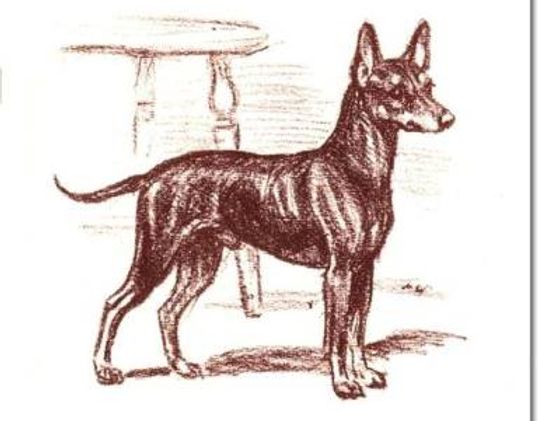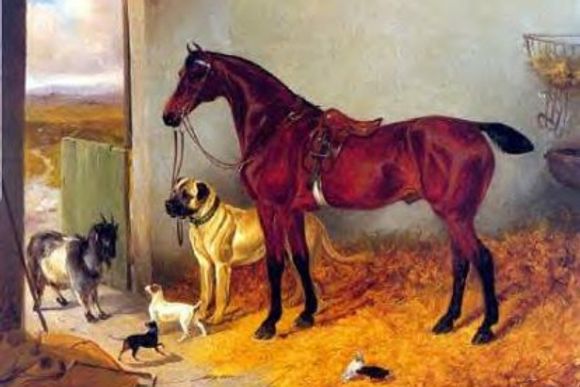The Evolution of the English Toy Terrier (Black & Tan)
The Perspective of History
By John R. F. Richardson (Reeberrich)
I will commence by providing some of my own background on this subject, as I will be not known, these days, to most exhibitors, and to certainly ever fewer as the decades roll by !
Although at University I read English; History has always been a real passion of mine, Architectural, Political (NOT dog politics, I’ve never got involved in those), Fashion, Art, Literature, but primarily Social History.
Researching the history of breeds I owned was always a natural ‘follow on ‘.
I began to research the background of the ETT even before I decided to have them. Once I was ‘in’ the breed, as time went on, other breed aficionados became cognisant of my interest, and thus correspondence and copies of articles & documents were forwarded on to me. Correspondents were Frank Palmer, Dorothy Hammett, Kitty Voce, Zoe Plowright, Colin Zarifi and Petronelle Kitson, all people with a long association with the breed, thus helping me link the past with the present.

So………where did it all begin!
There isn’t, of course, a true beginning; certainly, not yet definitively proven.
Ratting dogs, will have been in existence ever since a need was identified to control rats. These dogs would have been selected only on their ratting ability. Colour, size etc. would not have been a deciding factor until it was found over time that certain traits produced a better ratter.
Society became much more open with the rise of the ‘ middling’ classes, and the explosion of the industrial revolution in Georgian England.

There is documented evidence that small ratters were carried in leather or canvas pouch bags. Some of the dogs are alleged to have followed the hunt, though it is difficult to imagine what their function would be (they may have flushed out rabbits etc.). As yet we have not reached the point where there is any resemblance to an ETT. Ratters, certainly, were kept in stables to keep vermin under control, some will have been small and even black and tan in colour, although not exclusively.
Regency dandies DID carry small Terriers in the ubiquitous leather satchel, along with the more generally associated swaggering stick (a short cane) carried to strike finger-smiths, undesirables & ne’er do wells). These diminutive dogs were regarded as a delightful fashion accessory. Colour again would be at the whim of each particular dandy.
Before this era, the only kept records on the breeding of dogs was by hunting kennels – Greyhounds, Deerhounds, Wolfhounds etc. It was the Victorians who would lead us into a more structured form of dog breeding and pedigree record keeping and into the evolution of the ETT ( please note I’m using this monicker, throughout, for ease of identification).

.
The 18th century saw a dramatic shift in the populated landscape of Britain, England particularly. In 1714 we imported a non English speaking German king from Hanover, which would result in a change to universal suffrage, the Rights of Man, and in the power of Parliament ( George I, spoke virtually no English, nor George II who preferred being in Hanover, to which he travelled frequently). On a domestic level the Industrial Revolution saw a dynamic shift by the population from a pastoral lifestyle to city dwellers.
Shuffling on rather hurriedly we come to the 19th century. By now cities are vastly overcrowded, short on accommodation, prone to outbursts of cholera, due to impure water supplies contaminated by sewage etc. Country folk had not anticipated the downside ramifications of becoming city folks, where they had arrived under a delusion of making one’s fortune on streets paved with gold.
It would have been the more successful integrators who, with a yearning for their rural past and with the financial wherewithal and facilities, could recreate a small corner of the English countryside in their back yard. Chicken keeping, gardening (of sorts) and the breeding of domestic livestock could be indulged ( rabbits, dogs, etc).
Through the Georgian/Victorian period, England was a bloodthirsty nation with a penchant for ‘ blood’ sports; bull baiting , bear baiting, dog fighting, cock fighting, and the bizarre sport of duck baiting. Even public hangings drew large crowds of men, women and children who would bring a picnic and make a day of it ! Into this mix came a vogue for organised rat-pitting. An entirely legal pursuit which was encouraged by Government to involve the public in assisting with vermin control. It was much followed by aristocrats and the poor alike.
By now it was common practice for the upper echelons to mingle more easily with the down at heel, particularly where sport and gambling might be involved. Rat pits evolved in the back room of public houses. Therefore ladies were not present. Ladies, used a ‘ parlour’ to rest and refresh on their journeys. Women described as ‘followers of Venus’ did frequent a certain type of drinking establishment away from polite society. The most celebrated example of a painting of a Rat Pit, is that attributed to the Society Beau, spectacularly named, Alfred Guillaume Gabriel Grimrod, Count D’Orsay (nb. no familial connection to the D’Orsay Musee, Paris), in which he includes himself as one of the spectators. Although he was somewhat more infamous for his scandalous private life, living in a menage a trois with Lord and Lady Blessington, which was no secret, and his reputation further compounded when he wed Lady Blessington’s 15 years old daughter from a previous marriage !
I don’t think there is a need here to describe the construction of a rat pit, as I’ll assume everyone already understands that.
An aspect worth mentioning though, and often overlooked, is that these rooms were usually quite dimly lit due to what was available to use as lighting, there being no electric lighting as yet.
The Rat
It is a common misconception that these rats were gathered up from any old place, not true. Only brown ‘ barn’ rats were used. These were transported from the countryside in wooden crates by a supplier who was paid by number supplied. The brown rat is larger than the black rat, and the black rat was associated with disease ( plague).
The Dog
Originally it was any sort of dog that showed some aptitude for ratting. Billy, a hefty 26 pounder, made something of a name for himself in the pit. He wasn’t black and tan, and one might imagine progress in the rat killing was a lugubrious affair. Tiny, The Wonder Dog, is the specimen most akin to the breed as it looks today. As the sport further developed, speed and efficiency and an increase in rat numbers provided, called for a more challenging type of dog. And NOW we have arrived at the small black and Tan terrier. So we come to the breed development proper.
Most Breeds followers seem to like to pinpoint a name on which they can attribute the development of their breed, eg, Amice Pitt CKCS, Captain John Edwardes the Sealyham Terrier, Parson John Russell, the PJRT, etc. The root for the Manchester terrier is given to Mr John Hulme. Although it’s doubtful any of these people would be developing their breeds in isolation. One needs enthusiasts working alongside you, as much for your own impetus as theirs. Hulme, rather stating the obvious, was in Manchester, and developed a breed of that name.
History has always indicated the ETT being the diminutive of Hulme’s Terriers. I was therefore considerably excited, during on-going researches to discover tantalising references that the diminutive black and tan, was being developed more in the south of England ( London) rather than in Manchester, and with no connections to Hulme’s Manchester Terrier ! This surprised me considerably as it was previously not something I’d given much thought to, tending to go with the promulgated Manchester area theory.
I cannot recall, now, whether any individuals were named in these documents I found. It does seem though that the smaller black and tan was preferred ‘darn sarth’ , whilst the bigger Manchester was more popular ‘oop North’. I read enough articles etc to believe this now to be true. This may mean that originally there was no direct genetic link in the ETT to the Manchester.
Although I should point out that as things progressed there was ‘ cross pollination’ between the two, which would today show up in DNA.
We have to bear in mind, until the advent of the railway, travelling was far more complicated, via stagecoach, horseback or just walking.
Most people, during their lifetime, never went further than 16 miles from their place of birth ( a day’s ride on horseback – if you were lucky enough to own one ). You may notice that most towns in Britain are about 16 miles apart. To give this more perspective, Jane Austen, a product of the middling classes, had such peripatetic fortunes as a spinster, with no personal fortune, that on occasions in her life, her family couldn’t afford to run their own carriage!
The Miniature Black and Tan Terrier
The development of the miniature black and tan came about as rat-pitting as a sport demanded a more evenly matched competition between dog & rat. It was the custom to bet on the outcome, so it needed to look feasible either dog or rats could be the victor. The dog needed to be swift and a lightly built terrier fitted that requirement.
All Black and Tan breeds of dogs mark in much the same way. Kissing spots, spots above the eye, tan legs, tan cheek spots, tan on the vent etc
This was seen as advantageous in the pit as it confused the Rat. Rats bite, and they’ll hang on like glue. Therefore, the dogs needed some protection. With the tan spots far brighter than the requisite ‘black’ eyes, these would be the focus for attack by the Rat, thus affording the dog some protection from being blinded, making it useless for further sport.
A narrow head meant the eyes were obliquely set; again a protection. This head shaping discouraged the dog wasting valuable time chewing at a rat as it’s jaw scissors action was better equipped to dispose of a rat in one bite, thanks to unpronounced zygomatic arches in the skull. Ears well back on head and erect kept them out of harm’s way. ( often the ears were cropped).
Even before the dog was placed into the pit, the rats would be scurrying about seeking means of escape. Once the dog was introduced you can imagine the mayhem both in AND out of the pit as betting became more animated.
Sometimes two dogs were placed in the pit and having successfully despatched the rats, they would then turn on one another in a killing frenzy. This wasn’t always discouraged or intervened, unless the dogs carried a certain value and reputation as a renowned ratter.
Dog Showing
We are now at the juncture where dog showing proper is in swing. Rat-pits by the late 19th century, had fallen into decline, as a more humane attitude towards canines developed, much of it thanks to the efforts of the RSPCA, and was replaced by the somewhat more refined hobby of dog exhibition. ( Although most blood sports became illegal as the Victorian era progressed, rat-pitting didn’t become illegal until 1911.
The last known event was at Leicester in 1912, where the promoter was prosecuted and fined).
The late Victorian & Edwardian ladies had a passion for tiny dogs and the ETT came under their scrutiny. This resulted in tiny, effete specimens with apple heads and the resulting round, large eyes that are traits of dwarfing down breeds. They lacked vigour and frequently succumbed to diseases, distemper etc. Markings and size became the most desirable attributes. Soundness of wind or limb was fairly much overlooked. The late Victorians also had developed a morbid fascination with taxidermy ( one I share with them!).
Stuffy
When I used to give lectures on the breed, as well as bringing along live specimens, I also took Stuffy.
Stuffy was, as her name implies, a taxidermy ETT dated the beginning of the 20th century. Diminutive in size, and a better head than the two I shall comment on below, and from the photographs you can see how through half a century the head was developed and refined.
Stuffy gives a fascinating insight to how small the breed became, almost driving it to extinction. A common practice by taxidermists was to stitch together deceased puppy skins to create an alleged ‘ tiny’ specimen and pass it off as having been a living example.
There are just two examples extant( plus, of course, Stuffy) ,of small genuine ETTs, which makes them of great value both as an historical and commercially valuable asset. These are in the museum at Tring, Hertfordshire.
I have visited and seen them on display and discussed them with the curator. They are definitely authentic and correct. As indeed is Stuffy.
The Breed Club
In 1938 a dedicated band of breed enthusiasts gathered at the Crufts breed benches and formed the Breed Club, with the name Miniature Black & Tan Terrier. On April 1st 1960, the breed and the Club were renamed the English Toy Terrier (Black & Tan).
Late 20th Century
In the late 20th century as the world seemed to grow smaller, there was an uptake in ETTs being exported, particularly to Finland ( late 1980s, early 1990s). In the 1960s a Toy Manchester Terrier, (Eaglespur) Bummet Brook Ol’ Angus was imported into Britain from the USA, but he was not well received by British breeders, virtually unused, and sired only a handful of litters. Although he does appear back in some British bloodlines pedigrees.
There was nothing new in some of the British breeders exporting specimens to Europe etc, but no one sent stock to America for many decades, as at that time the Toy Manchester Terrier was held to be a different breed from the ETT. In 1991 I found myself breaking ranks with British breeders, resulting in much controversy, when I exported an ETT to the Velvet Firefly’s kennel in the USA where he made a significant impact as a sire, winning his own title and siring 11 champions.
Eventually some British breeders came to terms with it and looked into the merits of bringing imports into Britain to open the rapidly decreasing gene pool here. The first came in 1995 from Australia and then in the 2000s from the USA.
The ETT, originally a gentleman’s dog, as is evidenced by the rat pit photographs ( no women are present) has never achieved tremendous popularity, but a core of dedicated enthusiasts,now both men and women, have over the decades ensured the continuance of the breed with a number of notable specimens distinguishing themselves in the ring, the whelping box and/or as stud dogs.
Vulnerable Breed Watch List
Breeders, aware of the ETT being currently Kennel Club listed as a vulnerable breed due to their comparatively low number of registrations, in the main, continue to share their good stock with each other for further enrichment of the breed as a whole.
